July 1998
Ralph Roberts and Cedric Clarke (W9885 - Spree Lady)
with Bob and Clare Harland (W9933 - Sea Rocket)
Part 3 of a Log
written and illustrated by Ralph Roberts
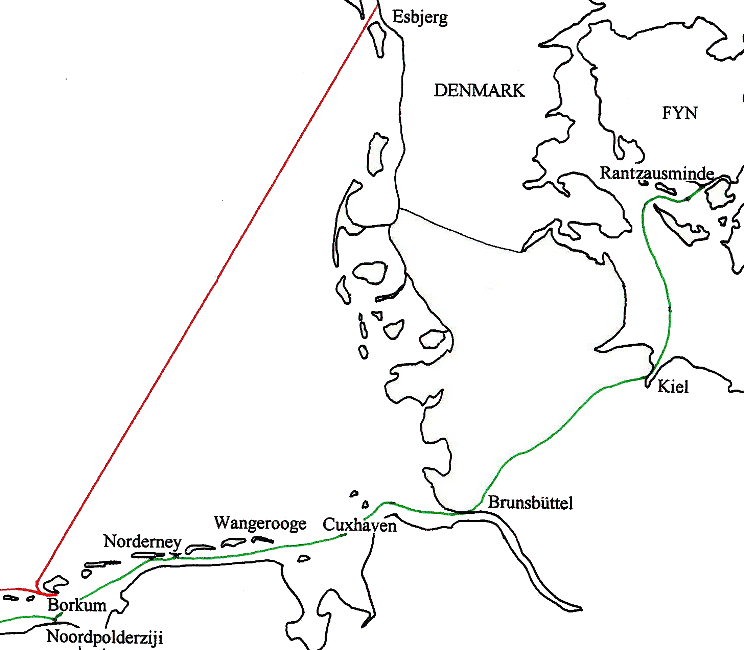
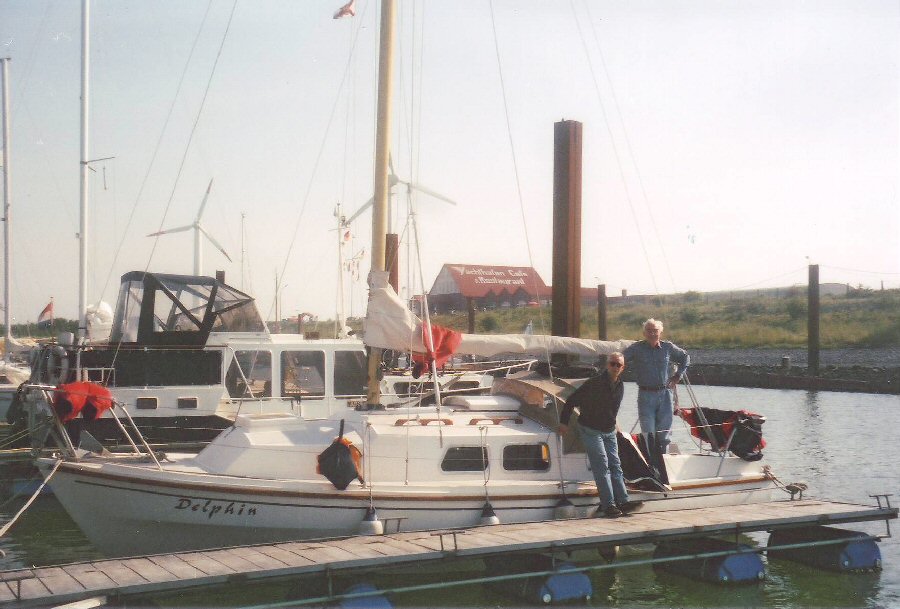
Gerhard Becher and his crew on their yacht Dolphin, moored adjacent to us.
Still with our offshore gear and various items of clothing spread out over his boat to dry!
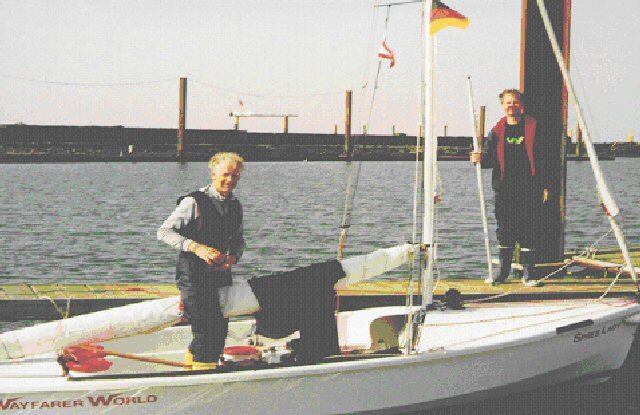
Making the final preparations aboard Spree Lady for our departure to Esbjerg.
Cedric standing on the jetty with the spinnaker pole. Photo taken by the crew of the yacht Dolphin.
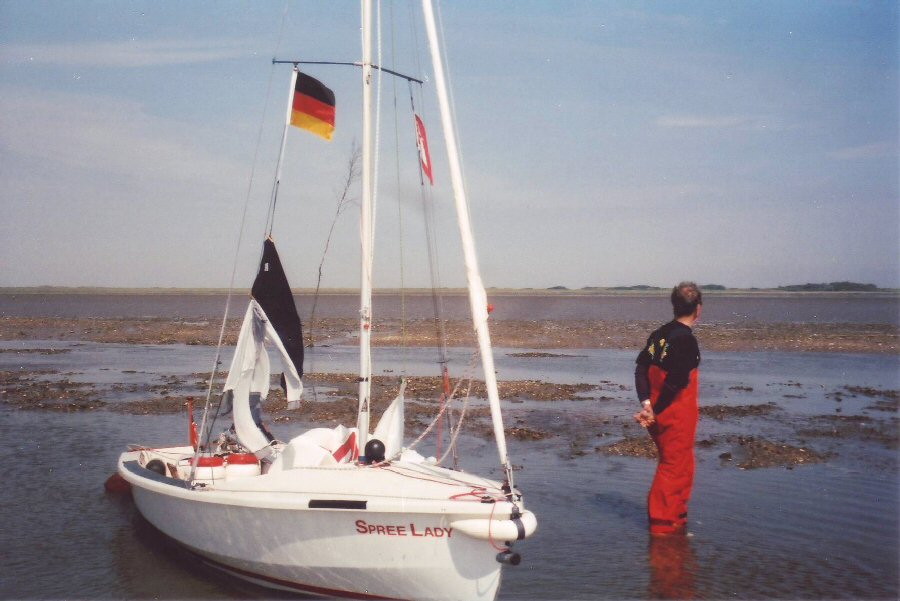
Stopped in the shallow channel on the fast receding tide, with Cedric looking north to the island of Borkum.
My wet sailing gear has been hung up to dry in the sun, after getting a foot stuck in the mud and falling in the water!
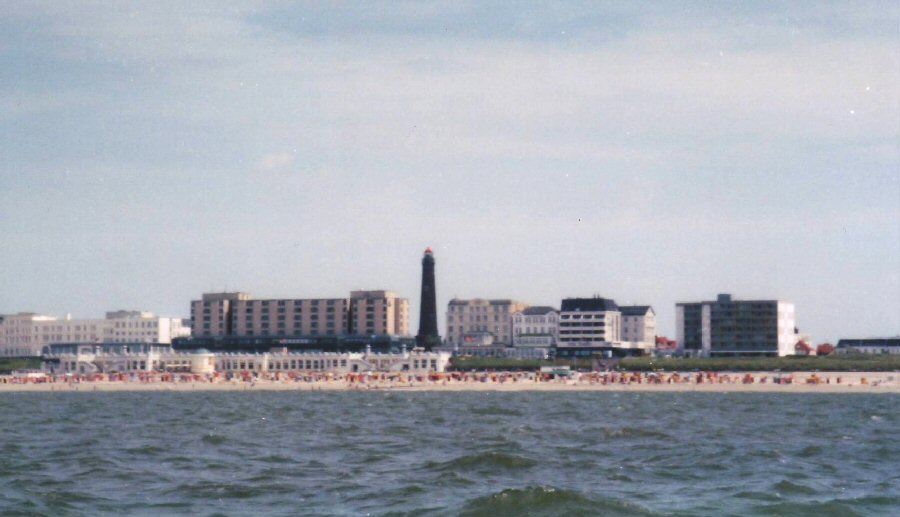
of the fine sunny weather. The fine sandy beach continued as a shallow spit for more than a mile out to sea.
We then
had to fight our way out of the
By 1550
we had passed the Juister Riff N. cardinal mark, which confirmed our
position,
as well as the GPS reading of an average speed of 4 knots. With a
steady wind,
and the sea still relatively calm, we decided to try all three sails by
putting
up the asymmetric spinnaker as well. This gave us the best sail of the
whole
trip, and at one point we seemed to be planing along with the crest of
a small
wave for nearly a full minute - planing is always the most exhilarating
part of
any sail, but this one continued for far longer than I had ever
experienced
either previously, or since. Our speed improved to 5 knots, so that an
hour later,
we had covered the 5 n.m. to the TG7 cardinal
buoy, marking the start of the shipping lane.
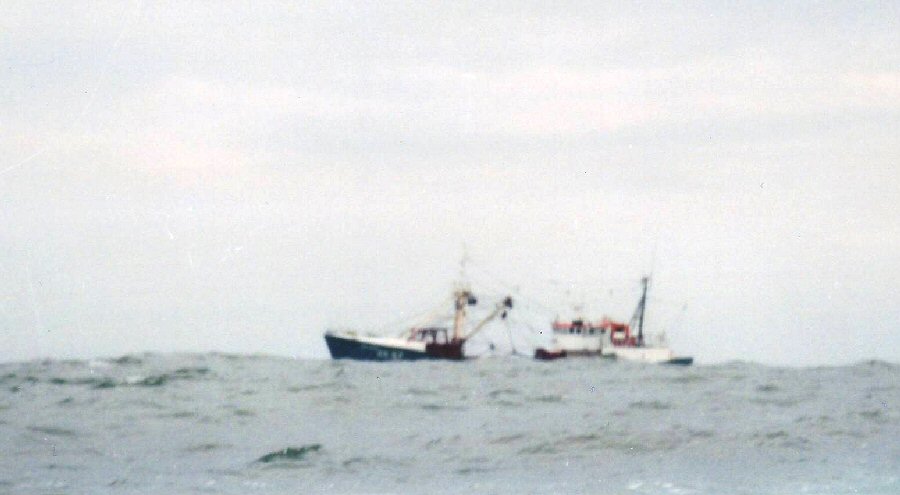
Passing a fishing
vessel near the first shipping lane,
with the weather starting to
deteriorate, and the sea beginning to get up.
WEATHER FORECASTS
There was no doubt that the conditions out at sea in the German Bight that night were severe, though because of the complete darkness, it was impossible to judge just how strong the winds were. Whilst I never considered that we were in any great danger, I certainly wouldn’t have ventured out of the harbour, had I known that gale force winds were imminent.
It was only when we received a letter from the skipper of the yacht we had met in Borkum Marina that we fully appreciated just how bad the conditions had been during the night. He reported that the wind had been so strong, that coupled with the noise of torrential rain, it had been impossible for them to sleep on their boat, moored safely in the marina!
At 1920, I got the
chart out in the evening drizzle to check on the
second shipping lane. With a further 18 n.m. to go, I calculated it
would take
another 3 to 4 hours, and would certainly be dark before we had
finished
crossing the lane. However, we had no option but to press on. The wind
gradually
increased until we needed to reef the main. I used the spinnaker pole
to push
out the genoa on the other side, and we creamed along at 6 to 7 knots
(from to the
GPS reading). We were most conscious of safety however, and made sure
we always
felt in full control of the boat.
...
At 0520, with the morning light clearing away the last remnants of darkness, I took another GPS reading and noted it on the chart. The wind had abated, and the sea calmed down just a little, so we decided to put up the reefed main. Whilst standing to do so, a wave lifted the front of the boat, causing me to fall backwards awkwardly and smash the back of my head against the end of the tiller. Thankfully I was wearing my canoe crash hat, though I still felt much of the impact through it. If I hadn’t been wearing the crash hat, I would have suffered an extremely serious - perhaps even fatal - injury. This was not my opinion, but that of Cedric, who is also a G.P.
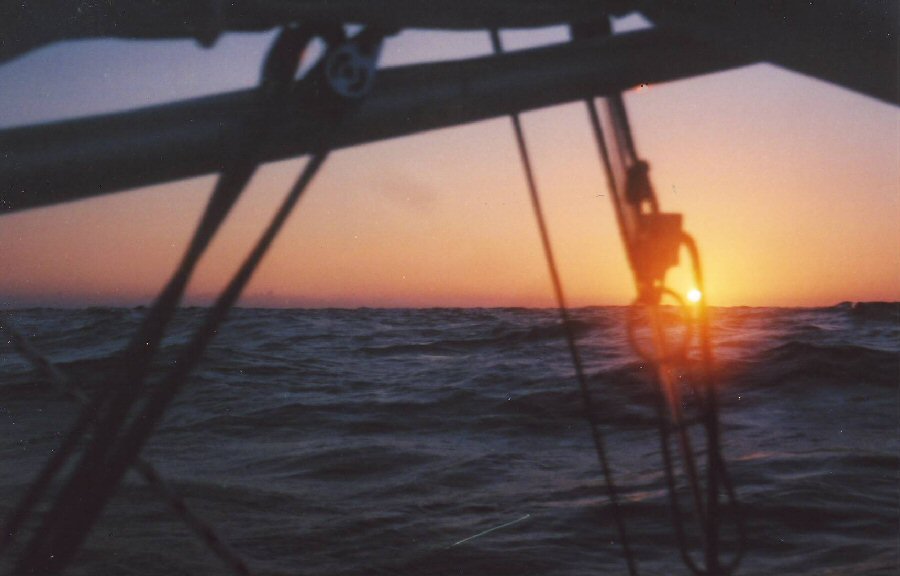
The very early dawn, with the sun emerging on the distant horizon and providing me
with some welcome warmth on the final day of our eventful crossing to Esbjerg.
Half an hour later, we were getting near to the point of being overpowered for an open sea cruise, and we discussed whether it would be prudent to take down the main. Cedric may well have been distracted by our discussion, because almost immediately, Spree Lady broached. We were only just able to prevent a capsize, as water poured in over one side. Once we were back upright, I wasted no time taking down the reefed main. It was to be the last time, we would have the main up until we reached Esbjerg. I changed the jib over to the genoa, which I pushed out with the spinnaker pole, and checked our speed on the GPS, which still showed we were making 5 to 6 knots.
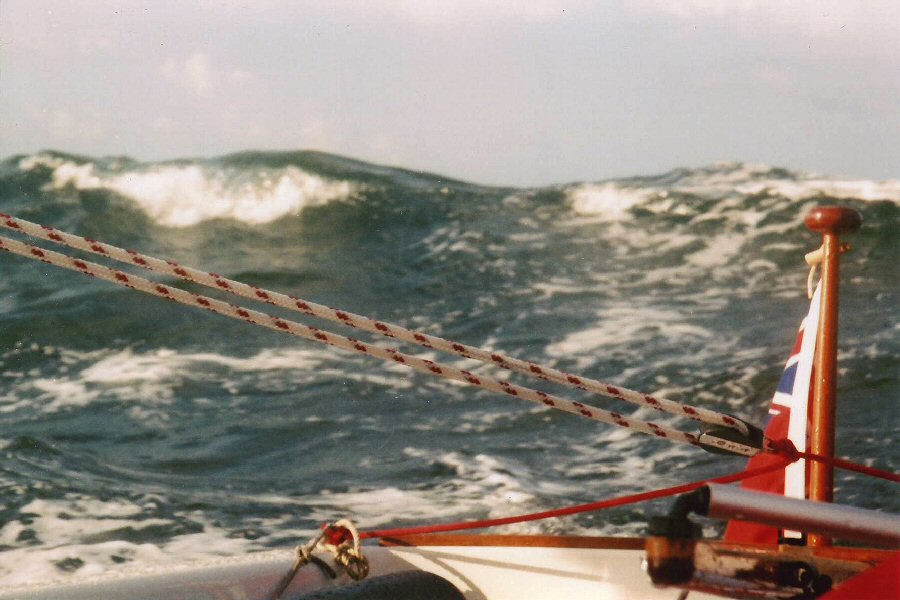
This was the start of the big seas we were to encounter on the final leg of our trip to Esbjerg.
Standing up to take the photo would have given a better perspective of the two sets of waves in the picture - sitting down to take it was a lot safer! The end of the tiller that made contact with my head is visible in the bottom right corner.
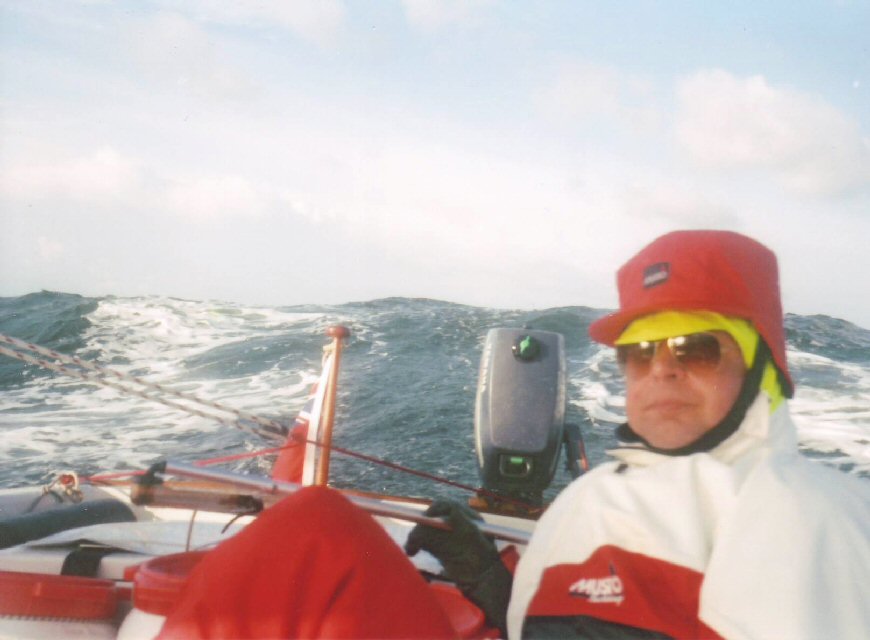
Cedric planing down the face of the wave behind - which was much larger than it looks from the photo! The track of the boat is marked by the dark, flat water, with the foam being scattered on either side. Still with the reefed mainsail up at this point.
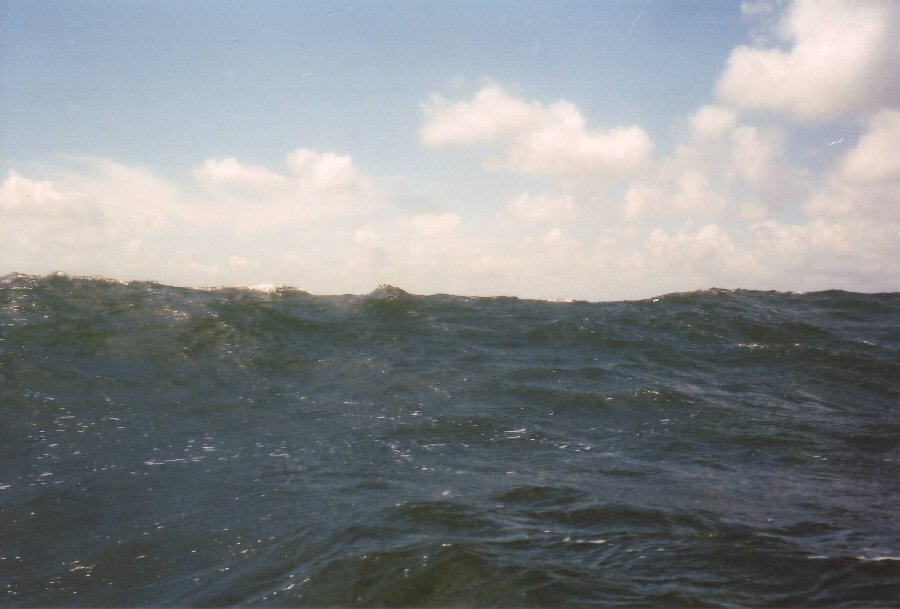
This series of photos, taken during the day, illustrate how the conditions deteriorated,
with big seas and the dark threatening clouds building in the sky.
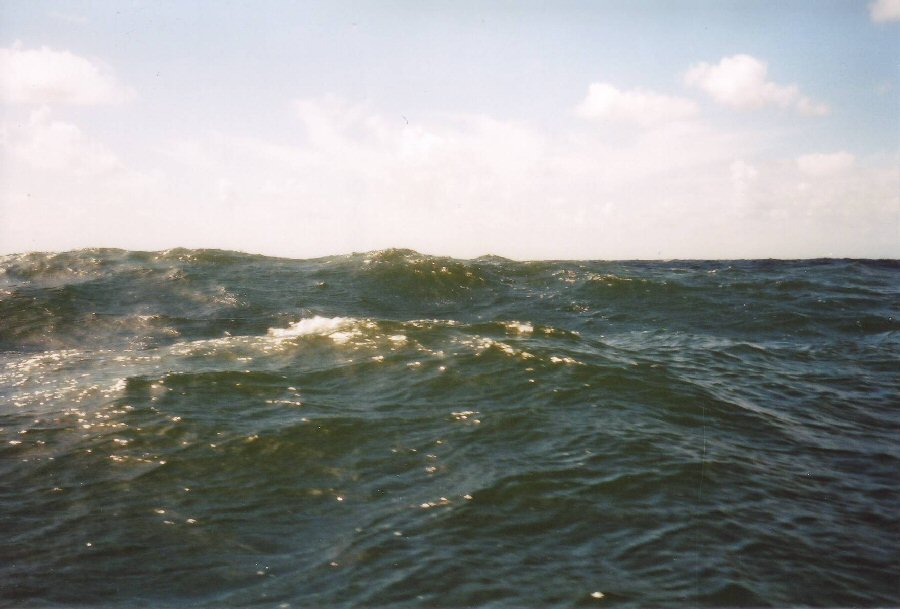
As the waves weren’t actually breaking, we were able to ride over them with ease
and they gave us no real cause for concern.
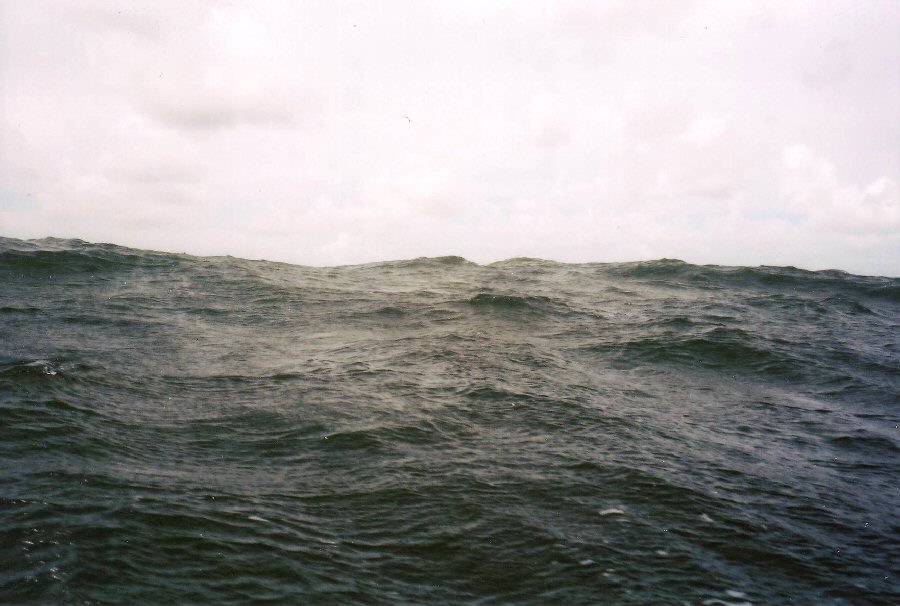
exaggeration - to be around 30 to 40 ft from trough to peak.
At midday I tried the GPS again, which this time came up with a bearing, much to my relief. The wind had increased in strength, probably to F.8 or more - it was difficult to judge in such strong winds and big seas. It certainly seemed far wilder than a previous F.8 I had sailed in, though this may well have been due to being out in such exposed conditions, rather than the wind strength.
It seemed prudent to change the genoa down to a jib. Although the seas were the biggest I have ever experienced in a Wayfarer, the sailing was surprisingly comfortable, and we never felt in any sort of danger. Had the wind increased still further, I was confident that we could have furled the wet jib down to only a ‘pocket handkerchief’ size, and run to a port of safety, only 10 n.m. to the east of us
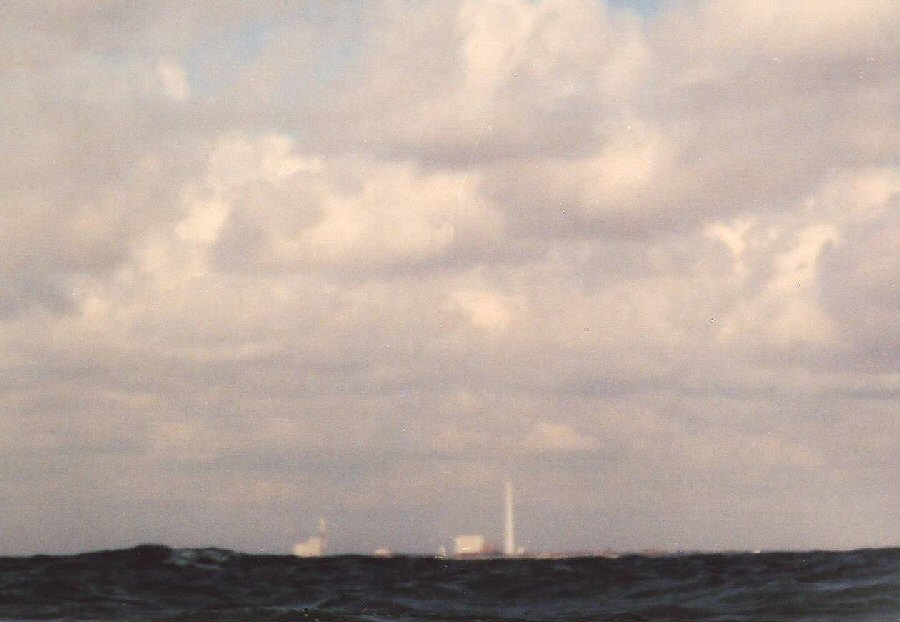
Esbjerg's distinctive industrial chimney landmark was visible from over 20 n.m. off the coast.
The strong onshore winds had created an area of turbulent water far further out from the shallows off Fanø than I had expected from my large scale chart. I altered course to get as far to seaward as possible of the rough water ahead, but with only the jib up, it was too late to avoid it altogether. For the next 15 minutes or so, Spree Lady was tossed about in the short steep waves like an item of clothing in a washing machine. We were more than a little relieved to reach the safety of the deep water channel into Esbjerg. Approaching the end of the channel, between Fanø and the mainland, we turned north to make for the Ho Bugt Sailing Club, where one of my Danish Wayfarer friends, Jens Konge Rasmussen had recommended we land.
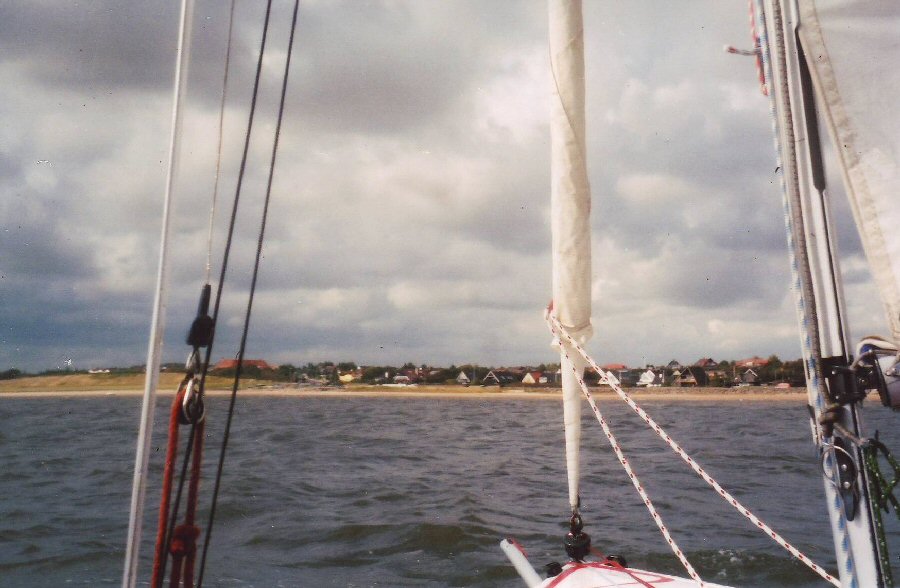
Approaching the Ho Bugt Sailing Club to the north of Esbjerg, which has its own large fleet of Wayfarers.
The asymmetric pole is still out the front of the boat,
unable to be pulled back through all the gear stored under the foredeck.
out at sea.
There had been little chance to celebrate the success of our trip the previous evening, but during the next morning there had been more time to contemplate our achievement. We had covered the 140 n.m. from Borkum in 28 hours at an average speed of 5 knots, mostly under jib or genoa only. We had arrived somewhat tired, hungry, wet, bumsore, and with my fingers swollen from salt water getting into cuts and grazes. But we had made it, and the exhilaration of completing the trip more than made up for the various discomforts.
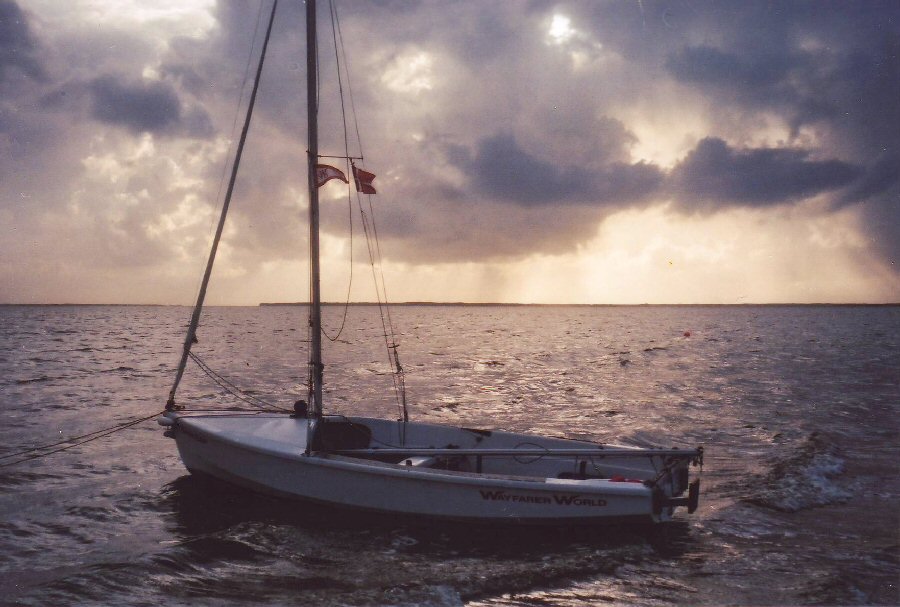
The threatening black skies warn of the severe gale about to blow through.
2. I should have involved Cedric much more with the navigation and passage planning for this part of the trip, rather than taking sole responsibility. Had I not been wearing a canoe crash hat when I fell backwards, my injuries would have resulted at the very least, in a severe concussion. It is certain that I would have been totally incapable of assisting Cedric, who had no navigation experience, in a totally unknown and hostile environment.
3. I had purchased six Admiralty charts, both large and small scale to cover the areas I planned to sail, giving sufficient detail to cover possible safe havens should this become necessary. The only area I didn’t have in detail was the approach into Esbjerg, the detailed coastal chart of this region finishing just a few degrees below the port. In an effort to economise, I relied on my large scale chart for entry into Esbjerg, together with detailed sketches of the estuary sent to me by my Danish colleague. Trying to save a few pounds proved a false economy, and meant that my approach to Esbjerg was closer to the island of Fanø than would probably have been the case had I had a more detailed chart. This resulted in a much rougher and potentially dangerous finish to our passage.
4. I should have purchased a radio with built in tape recorder to ensure I didn’t miss the BBC shipping forecasts, rather than relying solely on being provided with weather forecasts from local sources. I would certainly not have set out from Borkum had I known we would encounter such extreme conditions.
A submarine exercise area is marked on the charts of the German Bight between the two shipping lanes, and a submarine in the area may have picked up the Coastguard alert and used it as an exercise to find and track us. It seems the only explanation as to why we were shadowed so closely for some considerable time, until I altered course to indicate that I felt they were a danger to us. The submarine appeared to recognise this and also altered course, as their light diverged from us more quickly than could be accounted for by only my own slight change of course. The light then continued to follow us from a further distance through the remaining darkness of night, until it was lost in the early morning light. It is now apparent that I should have made more effort to notify the German Coastguard of our proposed crossing.
Ralph Roberts W9885 Spree Lady
...
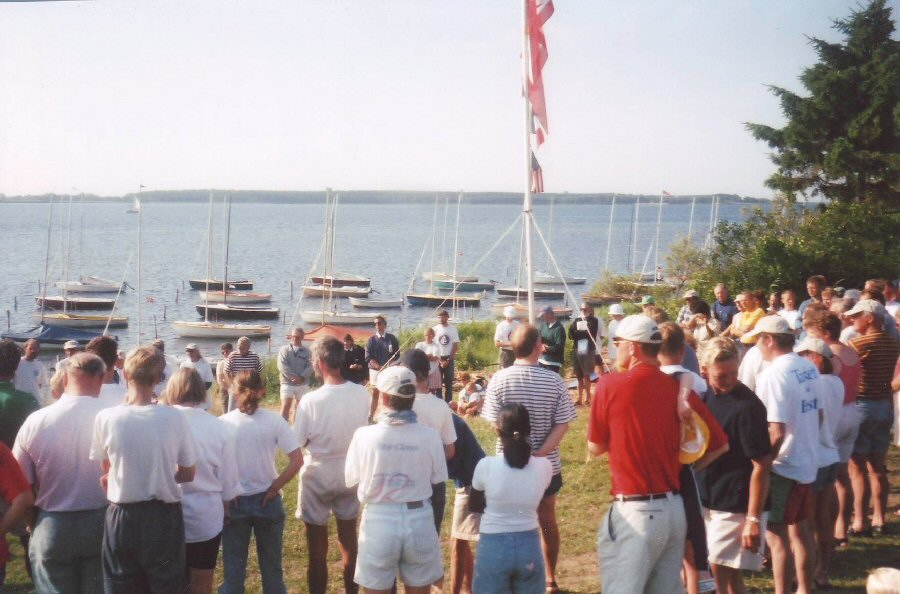
Crews from the International gathering of over 70 Wayfarers being briefed for the day’s proposed sail.
It is the most perfect location for sailing that I have had the good fortune to visit.
Nowhere else could you simply walk only 50 to 100 m. from your tent or camper to your boat, and set off to sail.
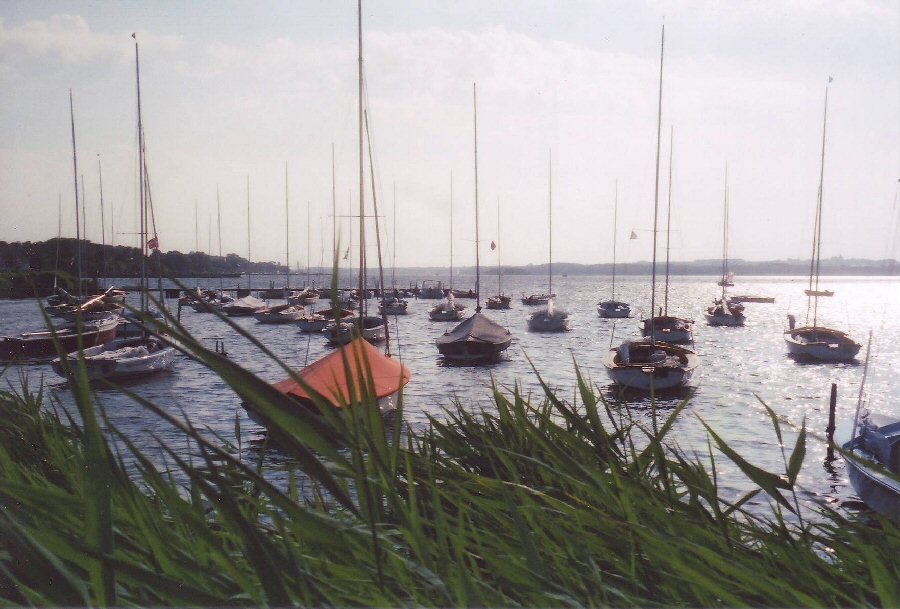
The sailing in the area couldn’t be more ideal, with many islands and places of interest to visit.
With a choice of many directions in which to sail, most trips can be organised by sailing on an easy reach.